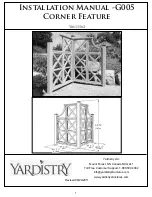
No.
Test
Test description
4
Winding or
Burden
Resistance
The resistance (not impedance) is measured connecting the low DC current source to
the winding or burden, and measuring the test current and the voltage drop.
Input parameters are the following:
•
The nominal resistance
•
The connected output
•
The test current
•
The resistance limits
It is also possible to compensate the test temperature. The test set controls the output
current and voltage during the test, and stops as the test current is reached. The display
shows the following:
•
The test current
•
The voltage drop
•
The measured resistance and the compensated resistance
•
The test duration
•
The current deviation when the measurement was achieved
5
Voltage
Withstand
The test is performed connecting the high AC voltage source between the CT secondary
cabling and the ground or between the CT primary and secondary.
Input parameters are the following:
•
Maximum test current (with automatic switch-off)
•
Test time
•
Output range
•
Test voltage
•
Test frequency
The display shows the following:
•
During the HV ramping, the test voltage and current;
•
As the test is completed, the test voltage, the maximum current, the total
elapsed time, the isolation impedance (not resistance)
6
Polarity Check
The test is performed connecting the high AC current source to the primary side,
generating a special waveform, and measuring the induced secondary current with the
optional PLCK polarity sensor.
Input parameters are the following:
•
The test current
•
The generation duty cycle
•
The test result (OK or NO)
The display shows the test current and records the test result of the different points
7
Ratio Polarity
Voltage Mode
The ratio measurement is performed applying High V AC to the CT secondary, and
measuring the CT primary voltage.
Input parameters are the following:
•
The nominal primary and secondary current, from which the program computes
the nominal ratio
•
The voltage range
•
The nominal test voltage and the test frequency
The display shows the following:
•
The current test voltage on the secondary side
•
The secondary measured voltage and the secondary current with the nominal
primary current
•
Actual ratio and ratio error
•
Phase shift and polarity
Table 42 - Current Transformers tests (2/4)
Shop for Power Metering products online at:
1.877.766.5412
www.
PowerMeterStore
.ca
















































